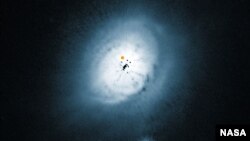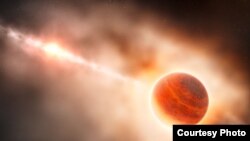An international team led by Swiss astronomer Sascha Quanz has made what could be the first direct observation of a planet in the process of being formed. It is still embedded in a thick disc of gas and dust encircling a relatively nearby young star - only about 335 light years from Earth.
The scientists expect that as the protoplanet continues to gather material from the disc over millions of years, it will develop into a gas giant similar to the planet Jupiter in our solar system.
ESO/L. Calçada video: flying through the HD100546 system
Quanz notes that until now, computer simulations were the only way to study planet formation. But using the advanced optics of the European Southern Observatory's Very Large Telescope and new image analysis techniques, astronomers were able to see a faint blob in the circumstellar disc. If his team's finding is confirmed, astronomers would be able to test their theories against an observable target.
Although a protoplanet is the most likely explanation for the observations, the results of this study require follow-up observations to rule out other possibilities and confirm the existence of the planet.
The scientists expect that as the protoplanet continues to gather material from the disc over millions of years, it will develop into a gas giant similar to the planet Jupiter in our solar system.
ESO/L. Calçada video: flying through the HD100546 system
Loading player...
Quanz notes that until now, computer simulations were the only way to study planet formation. But using the advanced optics of the European Southern Observatory's Very Large Telescope and new image analysis techniques, astronomers were able to see a faint blob in the circumstellar disc. If his team's finding is confirmed, astronomers would be able to test their theories against an observable target.
Although a protoplanet is the most likely explanation for the observations, the results of this study require follow-up observations to rule out other possibilities and confirm the existence of the planet.










